Occupational Health Management: Stress in Nursing, Report Analysis
VerifiedAdded on 2023/01/18
|10
|2237
|70
Report
AI Summary
This report provides a critical analysis of occupational health management, focusing on the issue of work-related stress among nurses in hospitals. It begins with an executive summary and introduction, outlining the significance of stress in the nursing profession. The report delves into background information, defining stress and its common signs and symptoms like anxiety, depression, and insomnia, and explores the factors contributing to stress, such as long working hours, patient demands, and staff shortages. It then examines the findings from research, identifying specific causes of stress, including tight deadlines and moral distress, and their impact on nurses, such as increased absenteeism and human errors. Legislative requirements, specifically the Occupational Safety and Health Act (OSH Act) in Australia, are discussed, along with an evaluation of their effectiveness. The report concludes with recommendations for addressing stress, including proper task assignments, work pattern programs, addressing understaffing, providing peer counselling, implementing care quality monitoring, and enhancing security measures. The report references 15 APA 6th edition references, offering a comprehensive overview of the issue.
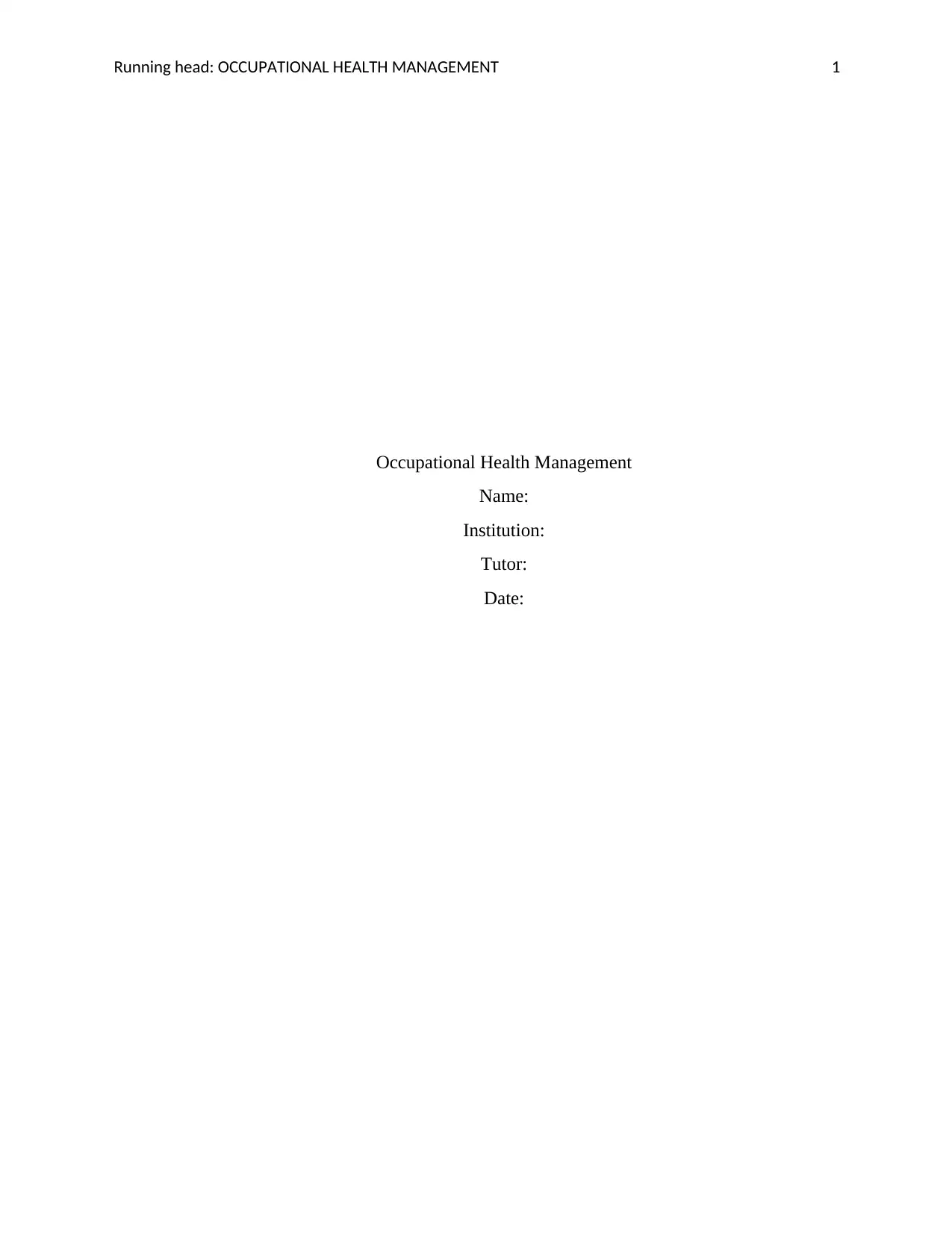
Running head: OCCUPATIONAL HEALTH MANAGEMENT 1
Occupational Health Management
Name:
Institution:
Tutor:
Date:
Occupational Health Management
Name:
Institution:
Tutor:
Date:
Paraphrase This Document
Need a fresh take? Get an instant paraphrase of this document with our AI Paraphraser
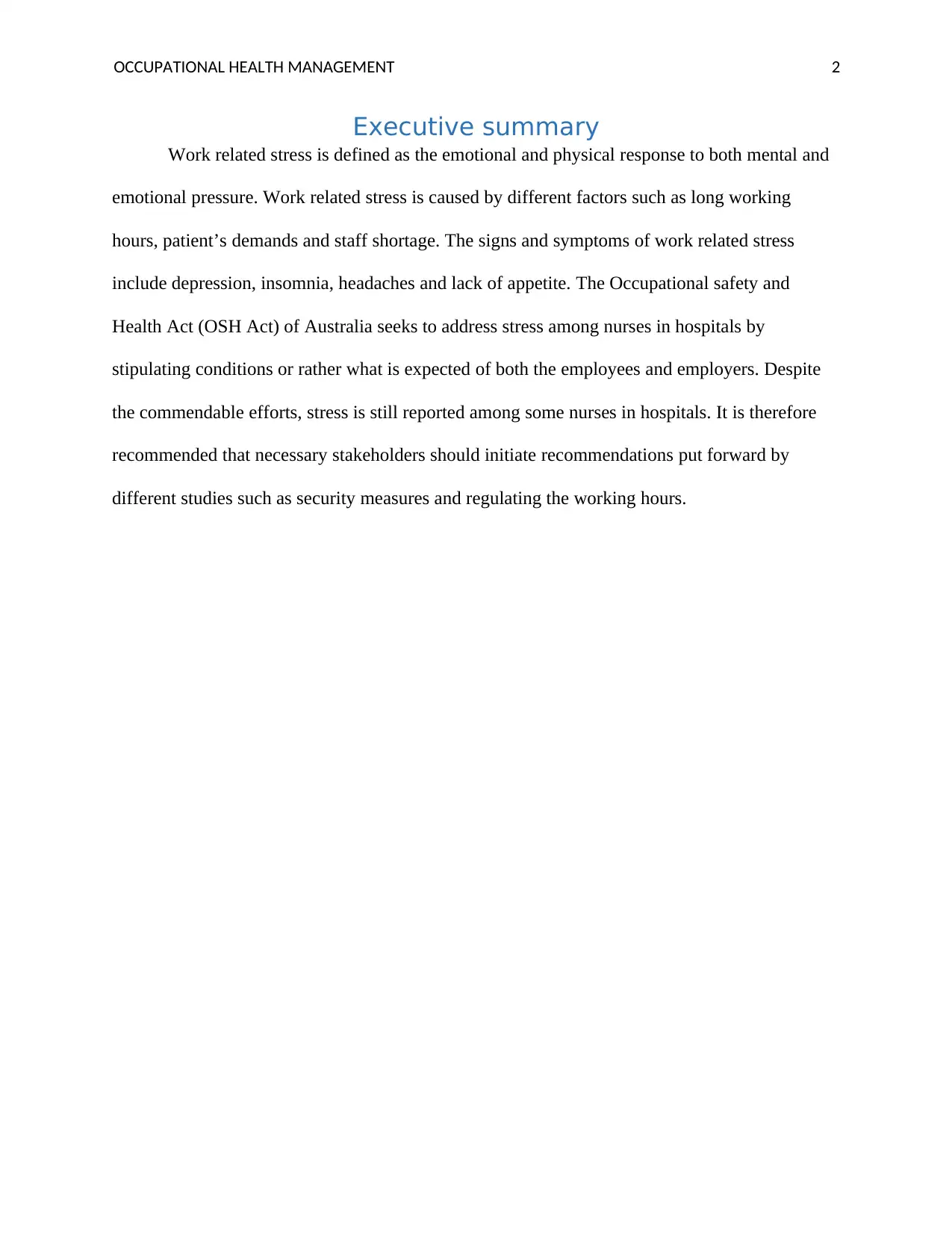
OCCUPATIONAL HEALTH MANAGEMENT 2
Executive summary
Work related stress is defined as the emotional and physical response to both mental and
emotional pressure. Work related stress is caused by different factors such as long working
hours, patient’s demands and staff shortage. The signs and symptoms of work related stress
include depression, insomnia, headaches and lack of appetite. The Occupational safety and
Health Act (OSH Act) of Australia seeks to address stress among nurses in hospitals by
stipulating conditions or rather what is expected of both the employees and employers. Despite
the commendable efforts, stress is still reported among some nurses in hospitals. It is therefore
recommended that necessary stakeholders should initiate recommendations put forward by
different studies such as security measures and regulating the working hours.
Executive summary
Work related stress is defined as the emotional and physical response to both mental and
emotional pressure. Work related stress is caused by different factors such as long working
hours, patient’s demands and staff shortage. The signs and symptoms of work related stress
include depression, insomnia, headaches and lack of appetite. The Occupational safety and
Health Act (OSH Act) of Australia seeks to address stress among nurses in hospitals by
stipulating conditions or rather what is expected of both the employees and employers. Despite
the commendable efforts, stress is still reported among some nurses in hospitals. It is therefore
recommended that necessary stakeholders should initiate recommendations put forward by
different studies such as security measures and regulating the working hours.
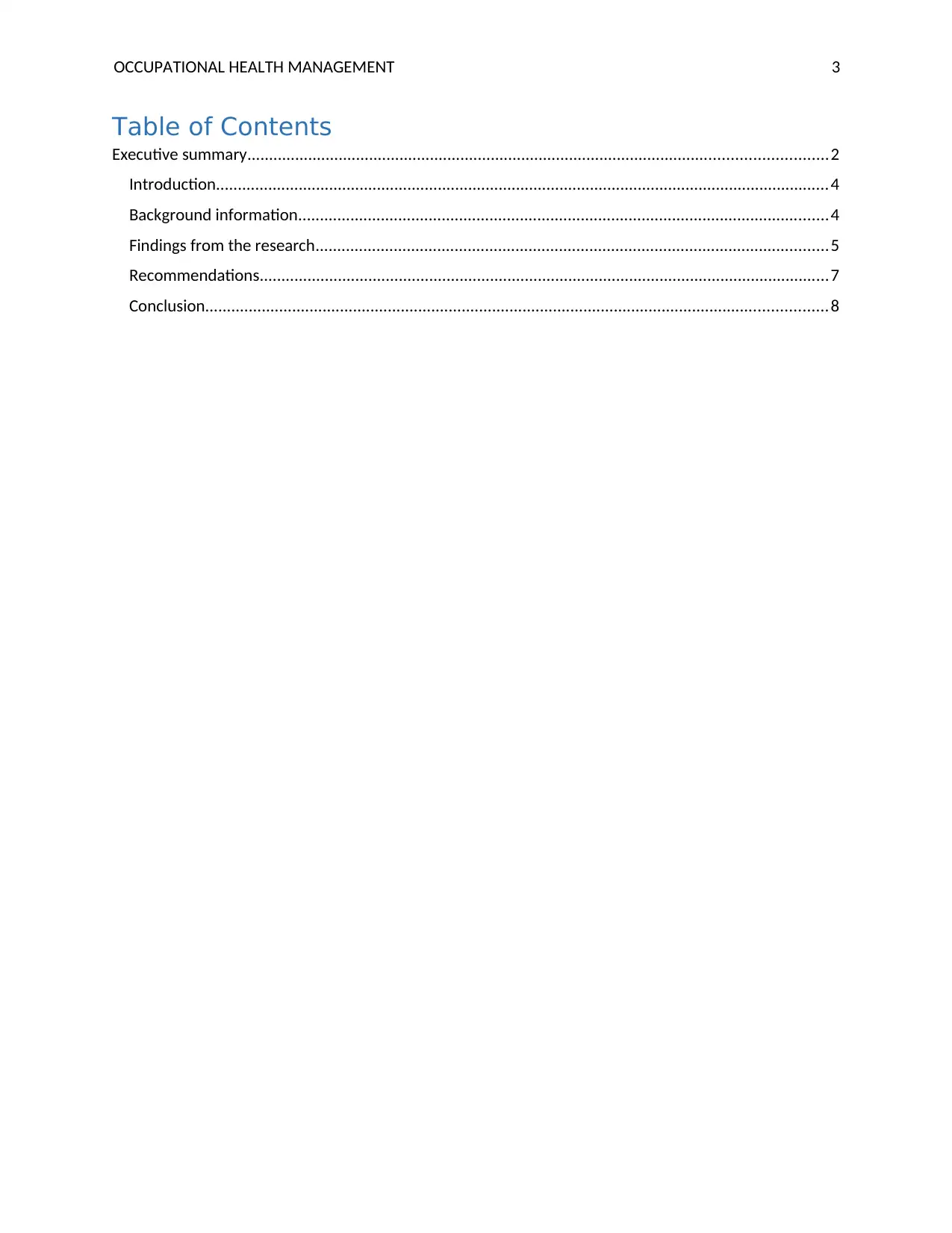
OCCUPATIONAL HEALTH MANAGEMENT 3
Table of Contents
Executive summary.....................................................................................................................................2
Introduction.............................................................................................................................................4
Background information..........................................................................................................................4
Findings from the research......................................................................................................................5
Recommendations...................................................................................................................................7
Conclusion...............................................................................................................................................8
Table of Contents
Executive summary.....................................................................................................................................2
Introduction.............................................................................................................................................4
Background information..........................................................................................................................4
Findings from the research......................................................................................................................5
Recommendations...................................................................................................................................7
Conclusion...............................................................................................................................................8
⊘ This is a preview!⊘
Do you want full access?
Subscribe today to unlock all pages.

Trusted by 1+ million students worldwide
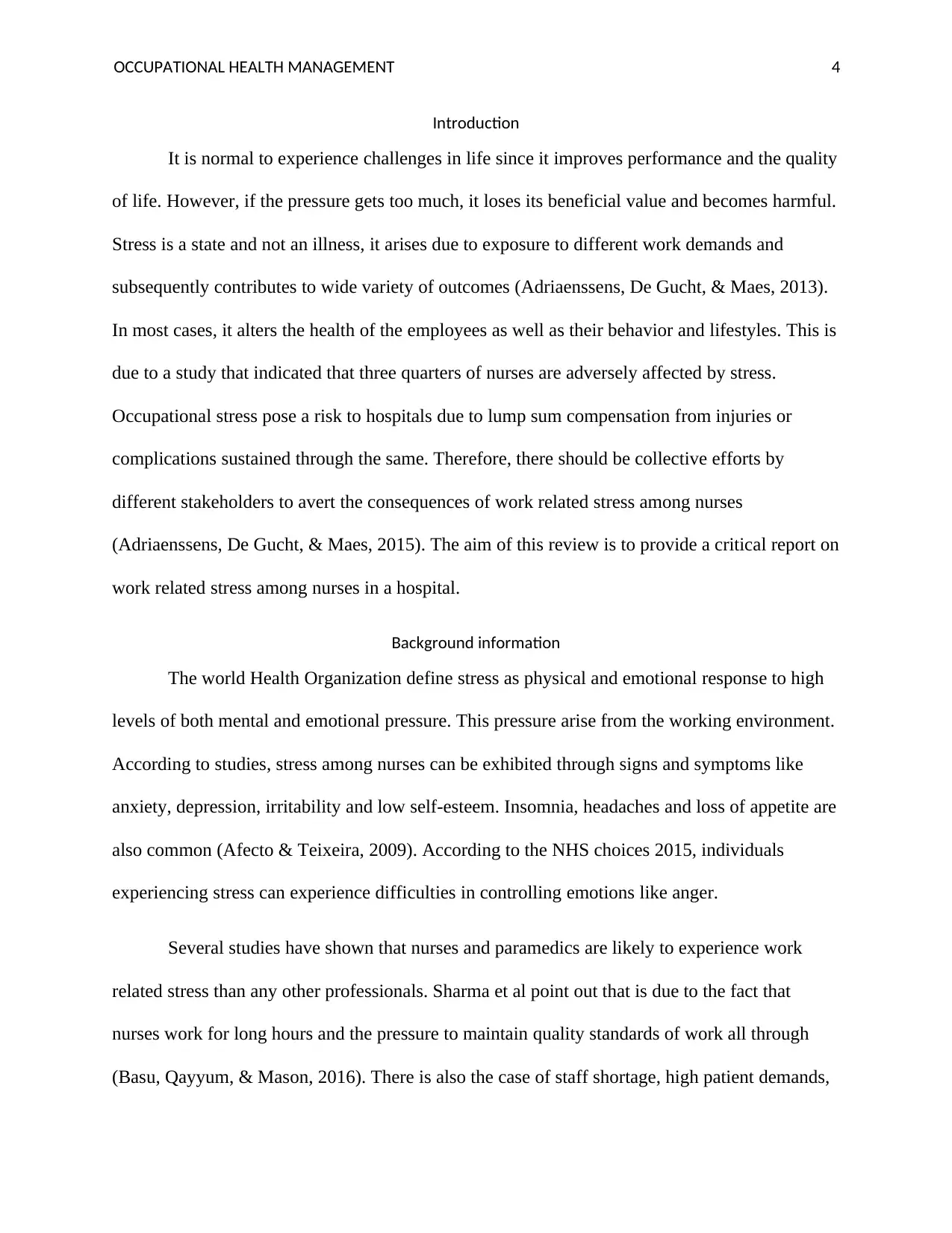
OCCUPATIONAL HEALTH MANAGEMENT 4
Introduction
It is normal to experience challenges in life since it improves performance and the quality
of life. However, if the pressure gets too much, it loses its beneficial value and becomes harmful.
Stress is a state and not an illness, it arises due to exposure to different work demands and
subsequently contributes to wide variety of outcomes (Adriaenssens, De Gucht, & Maes, 2013).
In most cases, it alters the health of the employees as well as their behavior and lifestyles. This is
due to a study that indicated that three quarters of nurses are adversely affected by stress.
Occupational stress pose a risk to hospitals due to lump sum compensation from injuries or
complications sustained through the same. Therefore, there should be collective efforts by
different stakeholders to avert the consequences of work related stress among nurses
(Adriaenssens, De Gucht, & Maes, 2015). The aim of this review is to provide a critical report on
work related stress among nurses in a hospital.
Background information
The world Health Organization define stress as physical and emotional response to high
levels of both mental and emotional pressure. This pressure arise from the working environment.
According to studies, stress among nurses can be exhibited through signs and symptoms like
anxiety, depression, irritability and low self-esteem. Insomnia, headaches and loss of appetite are
also common (Afecto & Teixeira, 2009). According to the NHS choices 2015, individuals
experiencing stress can experience difficulties in controlling emotions like anger.
Several studies have shown that nurses and paramedics are likely to experience work
related stress than any other professionals. Sharma et al point out that is due to the fact that
nurses work for long hours and the pressure to maintain quality standards of work all through
(Basu, Qayyum, & Mason, 2016). There is also the case of staff shortage, high patient demands,
Introduction
It is normal to experience challenges in life since it improves performance and the quality
of life. However, if the pressure gets too much, it loses its beneficial value and becomes harmful.
Stress is a state and not an illness, it arises due to exposure to different work demands and
subsequently contributes to wide variety of outcomes (Adriaenssens, De Gucht, & Maes, 2013).
In most cases, it alters the health of the employees as well as their behavior and lifestyles. This is
due to a study that indicated that three quarters of nurses are adversely affected by stress.
Occupational stress pose a risk to hospitals due to lump sum compensation from injuries or
complications sustained through the same. Therefore, there should be collective efforts by
different stakeholders to avert the consequences of work related stress among nurses
(Adriaenssens, De Gucht, & Maes, 2015). The aim of this review is to provide a critical report on
work related stress among nurses in a hospital.
Background information
The world Health Organization define stress as physical and emotional response to high
levels of both mental and emotional pressure. This pressure arise from the working environment.
According to studies, stress among nurses can be exhibited through signs and symptoms like
anxiety, depression, irritability and low self-esteem. Insomnia, headaches and loss of appetite are
also common (Afecto & Teixeira, 2009). According to the NHS choices 2015, individuals
experiencing stress can experience difficulties in controlling emotions like anger.
Several studies have shown that nurses and paramedics are likely to experience work
related stress than any other professionals. Sharma et al point out that is due to the fact that
nurses work for long hours and the pressure to maintain quality standards of work all through
(Basu, Qayyum, & Mason, 2016). There is also the case of staff shortage, high patient demands,
Paraphrase This Document
Need a fresh take? Get an instant paraphrase of this document with our AI Paraphraser
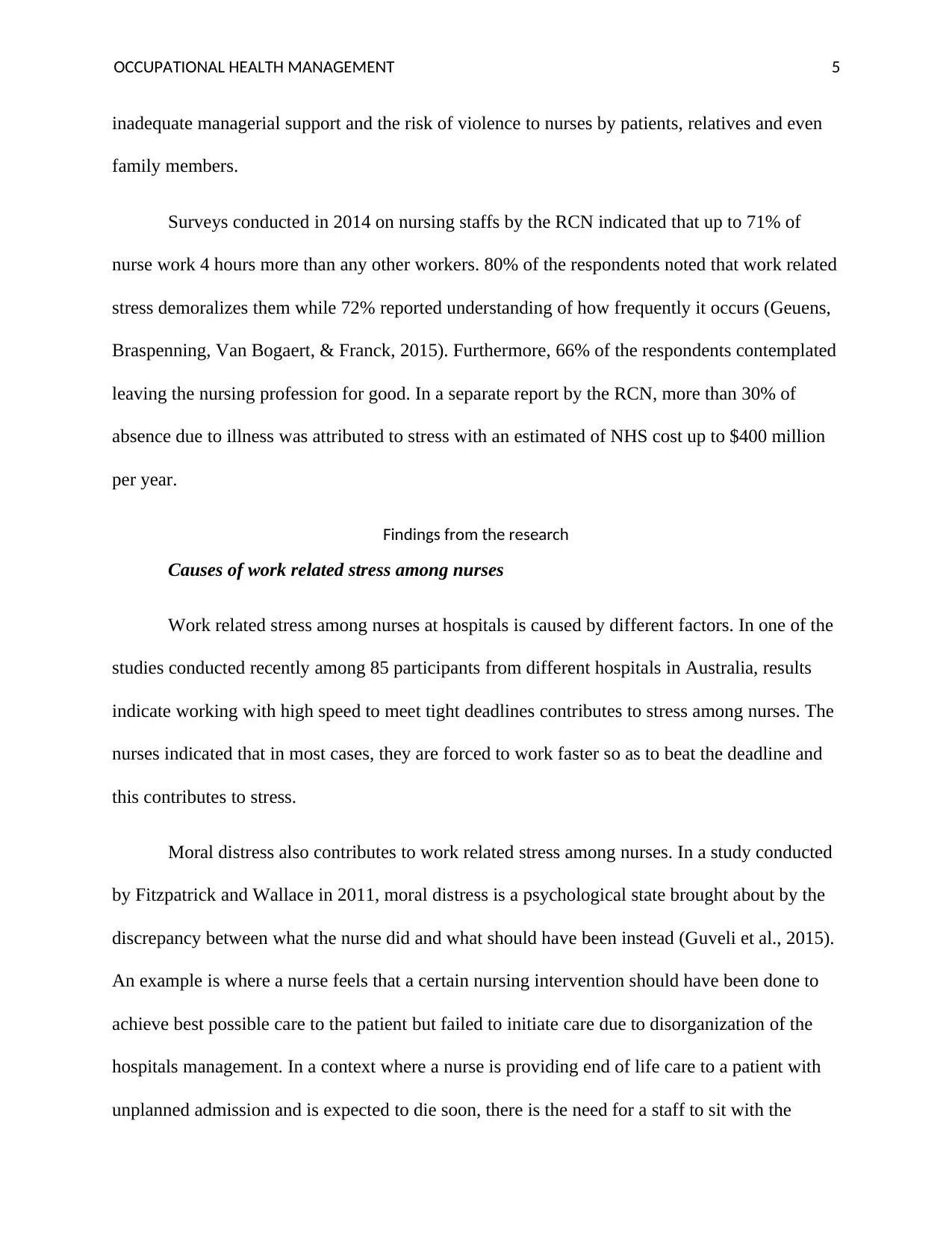
OCCUPATIONAL HEALTH MANAGEMENT 5
inadequate managerial support and the risk of violence to nurses by patients, relatives and even
family members.
Surveys conducted in 2014 on nursing staffs by the RCN indicated that up to 71% of
nurse work 4 hours more than any other workers. 80% of the respondents noted that work related
stress demoralizes them while 72% reported understanding of how frequently it occurs (Geuens,
Braspenning, Van Bogaert, & Franck, 2015). Furthermore, 66% of the respondents contemplated
leaving the nursing profession for good. In a separate report by the RCN, more than 30% of
absence due to illness was attributed to stress with an estimated of NHS cost up to $400 million
per year.
Findings from the research
Causes of work related stress among nurses
Work related stress among nurses at hospitals is caused by different factors. In one of the
studies conducted recently among 85 participants from different hospitals in Australia, results
indicate working with high speed to meet tight deadlines contributes to stress among nurses. The
nurses indicated that in most cases, they are forced to work faster so as to beat the deadline and
this contributes to stress.
Moral distress also contributes to work related stress among nurses. In a study conducted
by Fitzpatrick and Wallace in 2011, moral distress is a psychological state brought about by the
discrepancy between what the nurse did and what should have been instead (Guveli et al., 2015).
An example is where a nurse feels that a certain nursing intervention should have been done to
achieve best possible care to the patient but failed to initiate care due to disorganization of the
hospitals management. In a context where a nurse is providing end of life care to a patient with
unplanned admission and is expected to die soon, there is the need for a staff to sit with the
inadequate managerial support and the risk of violence to nurses by patients, relatives and even
family members.
Surveys conducted in 2014 on nursing staffs by the RCN indicated that up to 71% of
nurse work 4 hours more than any other workers. 80% of the respondents noted that work related
stress demoralizes them while 72% reported understanding of how frequently it occurs (Geuens,
Braspenning, Van Bogaert, & Franck, 2015). Furthermore, 66% of the respondents contemplated
leaving the nursing profession for good. In a separate report by the RCN, more than 30% of
absence due to illness was attributed to stress with an estimated of NHS cost up to $400 million
per year.
Findings from the research
Causes of work related stress among nurses
Work related stress among nurses at hospitals is caused by different factors. In one of the
studies conducted recently among 85 participants from different hospitals in Australia, results
indicate working with high speed to meet tight deadlines contributes to stress among nurses. The
nurses indicated that in most cases, they are forced to work faster so as to beat the deadline and
this contributes to stress.
Moral distress also contributes to work related stress among nurses. In a study conducted
by Fitzpatrick and Wallace in 2011, moral distress is a psychological state brought about by the
discrepancy between what the nurse did and what should have been instead (Guveli et al., 2015).
An example is where a nurse feels that a certain nursing intervention should have been done to
achieve best possible care to the patient but failed to initiate care due to disorganization of the
hospitals management. In a context where a nurse is providing end of life care to a patient with
unplanned admission and is expected to die soon, there is the need for a staff to sit with the
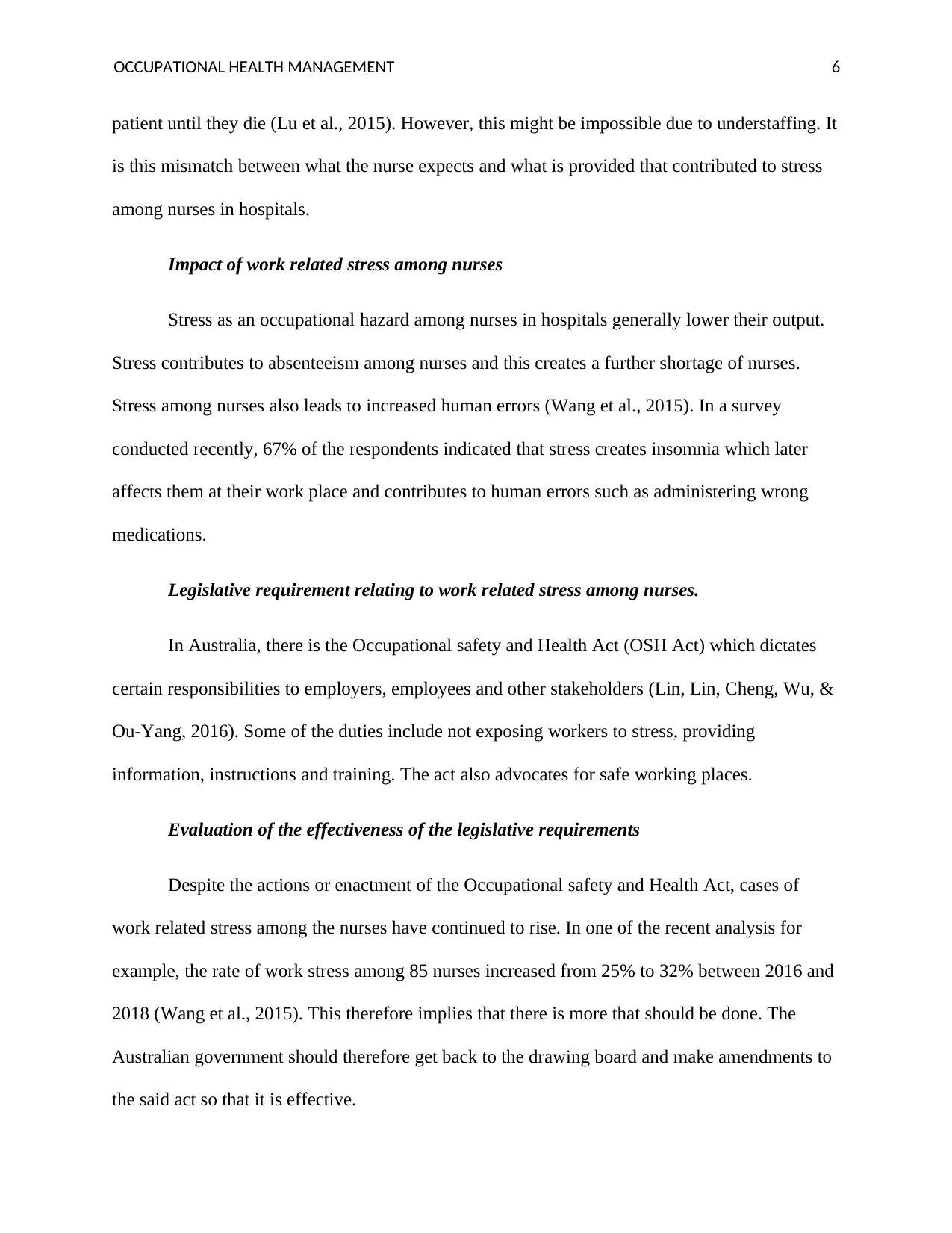
OCCUPATIONAL HEALTH MANAGEMENT 6
patient until they die (Lu et al., 2015). However, this might be impossible due to understaffing. It
is this mismatch between what the nurse expects and what is provided that contributed to stress
among nurses in hospitals.
Impact of work related stress among nurses
Stress as an occupational hazard among nurses in hospitals generally lower their output.
Stress contributes to absenteeism among nurses and this creates a further shortage of nurses.
Stress among nurses also leads to increased human errors (Wang et al., 2015). In a survey
conducted recently, 67% of the respondents indicated that stress creates insomnia which later
affects them at their work place and contributes to human errors such as administering wrong
medications.
Legislative requirement relating to work related stress among nurses.
In Australia, there is the Occupational safety and Health Act (OSH Act) which dictates
certain responsibilities to employers, employees and other stakeholders (Lin, Lin, Cheng, Wu, &
Ou-Yang, 2016). Some of the duties include not exposing workers to stress, providing
information, instructions and training. The act also advocates for safe working places.
Evaluation of the effectiveness of the legislative requirements
Despite the actions or enactment of the Occupational safety and Health Act, cases of
work related stress among the nurses have continued to rise. In one of the recent analysis for
example, the rate of work stress among 85 nurses increased from 25% to 32% between 2016 and
2018 (Wang et al., 2015). This therefore implies that there is more that should be done. The
Australian government should therefore get back to the drawing board and make amendments to
the said act so that it is effective.
patient until they die (Lu et al., 2015). However, this might be impossible due to understaffing. It
is this mismatch between what the nurse expects and what is provided that contributed to stress
among nurses in hospitals.
Impact of work related stress among nurses
Stress as an occupational hazard among nurses in hospitals generally lower their output.
Stress contributes to absenteeism among nurses and this creates a further shortage of nurses.
Stress among nurses also leads to increased human errors (Wang et al., 2015). In a survey
conducted recently, 67% of the respondents indicated that stress creates insomnia which later
affects them at their work place and contributes to human errors such as administering wrong
medications.
Legislative requirement relating to work related stress among nurses.
In Australia, there is the Occupational safety and Health Act (OSH Act) which dictates
certain responsibilities to employers, employees and other stakeholders (Lin, Lin, Cheng, Wu, &
Ou-Yang, 2016). Some of the duties include not exposing workers to stress, providing
information, instructions and training. The act also advocates for safe working places.
Evaluation of the effectiveness of the legislative requirements
Despite the actions or enactment of the Occupational safety and Health Act, cases of
work related stress among the nurses have continued to rise. In one of the recent analysis for
example, the rate of work stress among 85 nurses increased from 25% to 32% between 2016 and
2018 (Wang et al., 2015). This therefore implies that there is more that should be done. The
Australian government should therefore get back to the drawing board and make amendments to
the said act so that it is effective.
⊘ This is a preview!⊘
Do you want full access?
Subscribe today to unlock all pages.

Trusted by 1+ million students worldwide
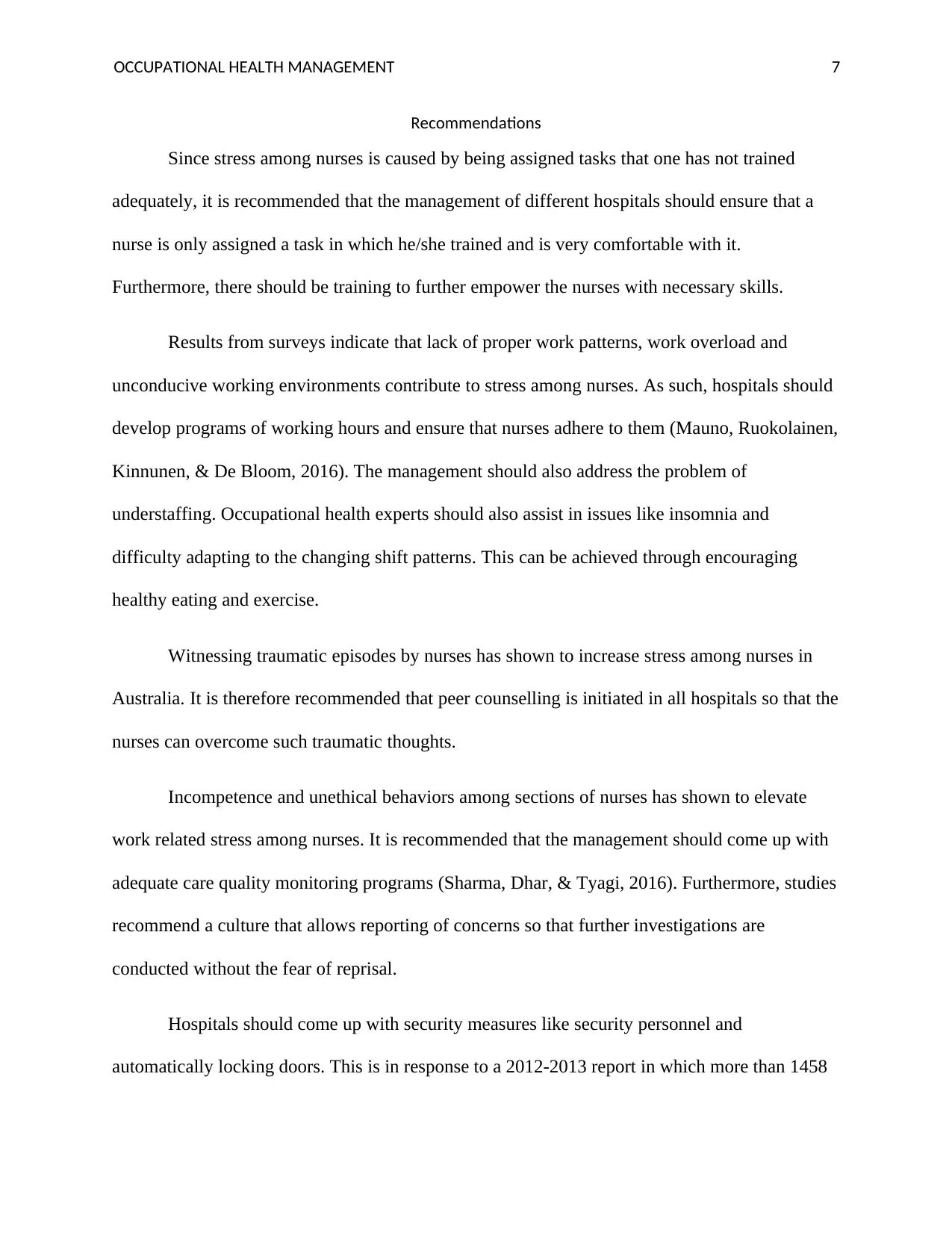
OCCUPATIONAL HEALTH MANAGEMENT 7
Recommendations
Since stress among nurses is caused by being assigned tasks that one has not trained
adequately, it is recommended that the management of different hospitals should ensure that a
nurse is only assigned a task in which he/she trained and is very comfortable with it.
Furthermore, there should be training to further empower the nurses with necessary skills.
Results from surveys indicate that lack of proper work patterns, work overload and
unconducive working environments contribute to stress among nurses. As such, hospitals should
develop programs of working hours and ensure that nurses adhere to them (Mauno, Ruokolainen,
Kinnunen, & De Bloom, 2016). The management should also address the problem of
understaffing. Occupational health experts should also assist in issues like insomnia and
difficulty adapting to the changing shift patterns. This can be achieved through encouraging
healthy eating and exercise.
Witnessing traumatic episodes by nurses has shown to increase stress among nurses in
Australia. It is therefore recommended that peer counselling is initiated in all hospitals so that the
nurses can overcome such traumatic thoughts.
Incompetence and unethical behaviors among sections of nurses has shown to elevate
work related stress among nurses. It is recommended that the management should come up with
adequate care quality monitoring programs (Sharma, Dhar, & Tyagi, 2016). Furthermore, studies
recommend a culture that allows reporting of concerns so that further investigations are
conducted without the fear of reprisal.
Hospitals should come up with security measures like security personnel and
automatically locking doors. This is in response to a 2012-2013 report in which more than 1458
Recommendations
Since stress among nurses is caused by being assigned tasks that one has not trained
adequately, it is recommended that the management of different hospitals should ensure that a
nurse is only assigned a task in which he/she trained and is very comfortable with it.
Furthermore, there should be training to further empower the nurses with necessary skills.
Results from surveys indicate that lack of proper work patterns, work overload and
unconducive working environments contribute to stress among nurses. As such, hospitals should
develop programs of working hours and ensure that nurses adhere to them (Mauno, Ruokolainen,
Kinnunen, & De Bloom, 2016). The management should also address the problem of
understaffing. Occupational health experts should also assist in issues like insomnia and
difficulty adapting to the changing shift patterns. This can be achieved through encouraging
healthy eating and exercise.
Witnessing traumatic episodes by nurses has shown to increase stress among nurses in
Australia. It is therefore recommended that peer counselling is initiated in all hospitals so that the
nurses can overcome such traumatic thoughts.
Incompetence and unethical behaviors among sections of nurses has shown to elevate
work related stress among nurses. It is recommended that the management should come up with
adequate care quality monitoring programs (Sharma, Dhar, & Tyagi, 2016). Furthermore, studies
recommend a culture that allows reporting of concerns so that further investigations are
conducted without the fear of reprisal.
Hospitals should come up with security measures like security personnel and
automatically locking doors. This is in response to a 2012-2013 report in which more than 1458
Paraphrase This Document
Need a fresh take? Get an instant paraphrase of this document with our AI Paraphraser
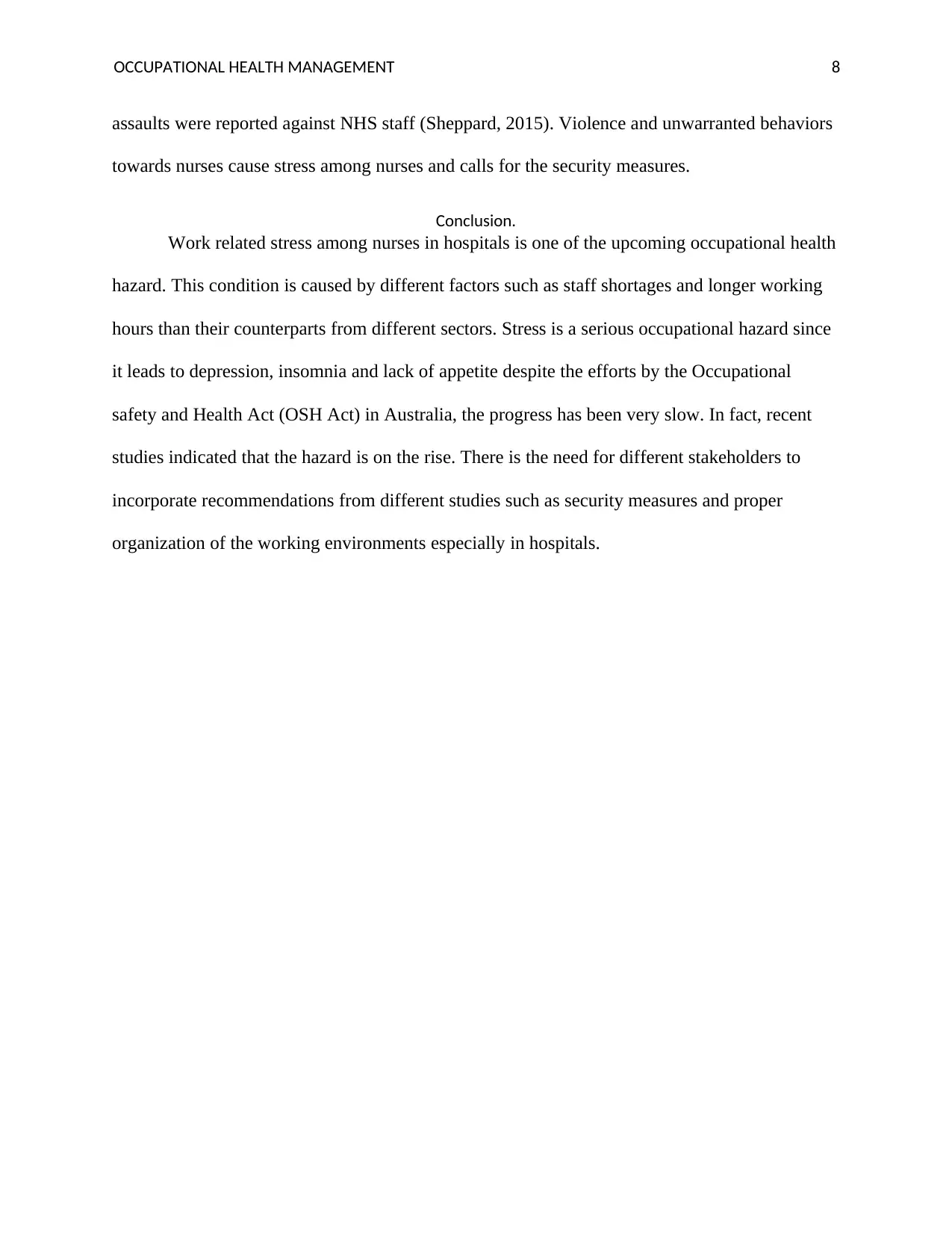
OCCUPATIONAL HEALTH MANAGEMENT 8
assaults were reported against NHS staff (Sheppard, 2015). Violence and unwarranted behaviors
towards nurses cause stress among nurses and calls for the security measures.
Conclusion.
Work related stress among nurses in hospitals is one of the upcoming occupational health
hazard. This condition is caused by different factors such as staff shortages and longer working
hours than their counterparts from different sectors. Stress is a serious occupational hazard since
it leads to depression, insomnia and lack of appetite despite the efforts by the Occupational
safety and Health Act (OSH Act) in Australia, the progress has been very slow. In fact, recent
studies indicated that the hazard is on the rise. There is the need for different stakeholders to
incorporate recommendations from different studies such as security measures and proper
organization of the working environments especially in hospitals.
assaults were reported against NHS staff (Sheppard, 2015). Violence and unwarranted behaviors
towards nurses cause stress among nurses and calls for the security measures.
Conclusion.
Work related stress among nurses in hospitals is one of the upcoming occupational health
hazard. This condition is caused by different factors such as staff shortages and longer working
hours than their counterparts from different sectors. Stress is a serious occupational hazard since
it leads to depression, insomnia and lack of appetite despite the efforts by the Occupational
safety and Health Act (OSH Act) in Australia, the progress has been very slow. In fact, recent
studies indicated that the hazard is on the rise. There is the need for different stakeholders to
incorporate recommendations from different studies such as security measures and proper
organization of the working environments especially in hospitals.
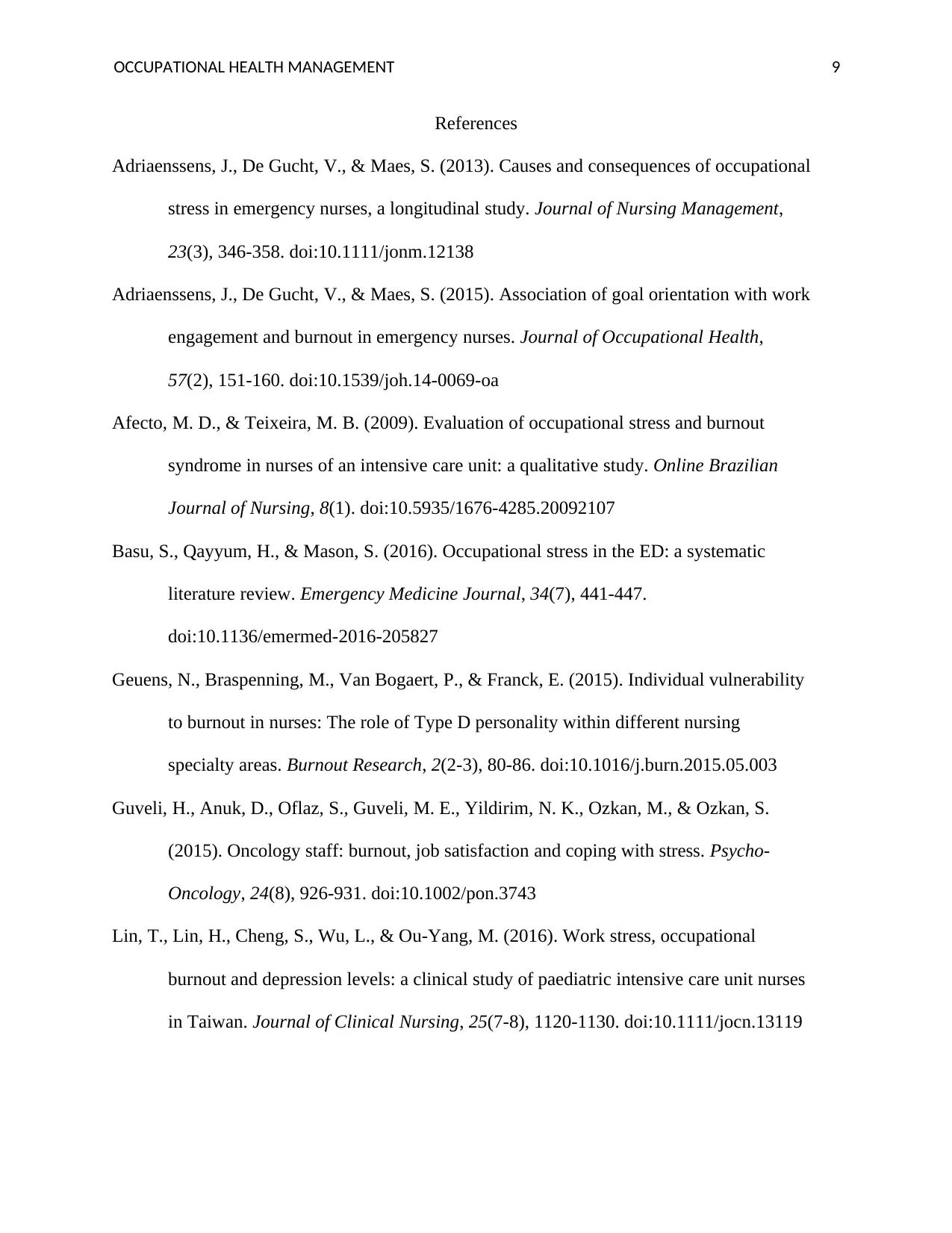
OCCUPATIONAL HEALTH MANAGEMENT 9
References
Adriaenssens, J., De Gucht, V., & Maes, S. (2013). Causes and consequences of occupational
stress in emergency nurses, a longitudinal study. Journal of Nursing Management,
23(3), 346-358. doi:10.1111/jonm.12138
Adriaenssens, J., De Gucht, V., & Maes, S. (2015). Association of goal orientation with work
engagement and burnout in emergency nurses. Journal of Occupational Health,
57(2), 151-160. doi:10.1539/joh.14-0069-oa
Afecto, M. D., & Teixeira, M. B. (2009). Evaluation of occupational stress and burnout
syndrome in nurses of an intensive care unit: a qualitative study. Online Brazilian
Journal of Nursing, 8(1). doi:10.5935/1676-4285.20092107
Basu, S., Qayyum, H., & Mason, S. (2016). Occupational stress in the ED: a systematic
literature review. Emergency Medicine Journal, 34(7), 441-447.
doi:10.1136/emermed-2016-205827
Geuens, N., Braspenning, M., Van Bogaert, P., & Franck, E. (2015). Individual vulnerability
to burnout in nurses: The role of Type D personality within different nursing
specialty areas. Burnout Research, 2(2-3), 80-86. doi:10.1016/j.burn.2015.05.003
Guveli, H., Anuk, D., Oflaz, S., Guveli, M. E., Yildirim, N. K., Ozkan, M., & Ozkan, S.
(2015). Oncology staff: burnout, job satisfaction and coping with stress. Psycho-
Oncology, 24(8), 926-931. doi:10.1002/pon.3743
Lin, T., Lin, H., Cheng, S., Wu, L., & Ou-Yang, M. (2016). Work stress, occupational
burnout and depression levels: a clinical study of paediatric intensive care unit nurses
in Taiwan. Journal of Clinical Nursing, 25(7-8), 1120-1130. doi:10.1111/jocn.13119
References
Adriaenssens, J., De Gucht, V., & Maes, S. (2013). Causes and consequences of occupational
stress in emergency nurses, a longitudinal study. Journal of Nursing Management,
23(3), 346-358. doi:10.1111/jonm.12138
Adriaenssens, J., De Gucht, V., & Maes, S. (2015). Association of goal orientation with work
engagement and burnout in emergency nurses. Journal of Occupational Health,
57(2), 151-160. doi:10.1539/joh.14-0069-oa
Afecto, M. D., & Teixeira, M. B. (2009). Evaluation of occupational stress and burnout
syndrome in nurses of an intensive care unit: a qualitative study. Online Brazilian
Journal of Nursing, 8(1). doi:10.5935/1676-4285.20092107
Basu, S., Qayyum, H., & Mason, S. (2016). Occupational stress in the ED: a systematic
literature review. Emergency Medicine Journal, 34(7), 441-447.
doi:10.1136/emermed-2016-205827
Geuens, N., Braspenning, M., Van Bogaert, P., & Franck, E. (2015). Individual vulnerability
to burnout in nurses: The role of Type D personality within different nursing
specialty areas. Burnout Research, 2(2-3), 80-86. doi:10.1016/j.burn.2015.05.003
Guveli, H., Anuk, D., Oflaz, S., Guveli, M. E., Yildirim, N. K., Ozkan, M., & Ozkan, S.
(2015). Oncology staff: burnout, job satisfaction and coping with stress. Psycho-
Oncology, 24(8), 926-931. doi:10.1002/pon.3743
Lin, T., Lin, H., Cheng, S., Wu, L., & Ou-Yang, M. (2016). Work stress, occupational
burnout and depression levels: a clinical study of paediatric intensive care unit nurses
in Taiwan. Journal of Clinical Nursing, 25(7-8), 1120-1130. doi:10.1111/jocn.13119
⊘ This is a preview!⊘
Do you want full access?
Subscribe today to unlock all pages.

Trusted by 1+ million students worldwide
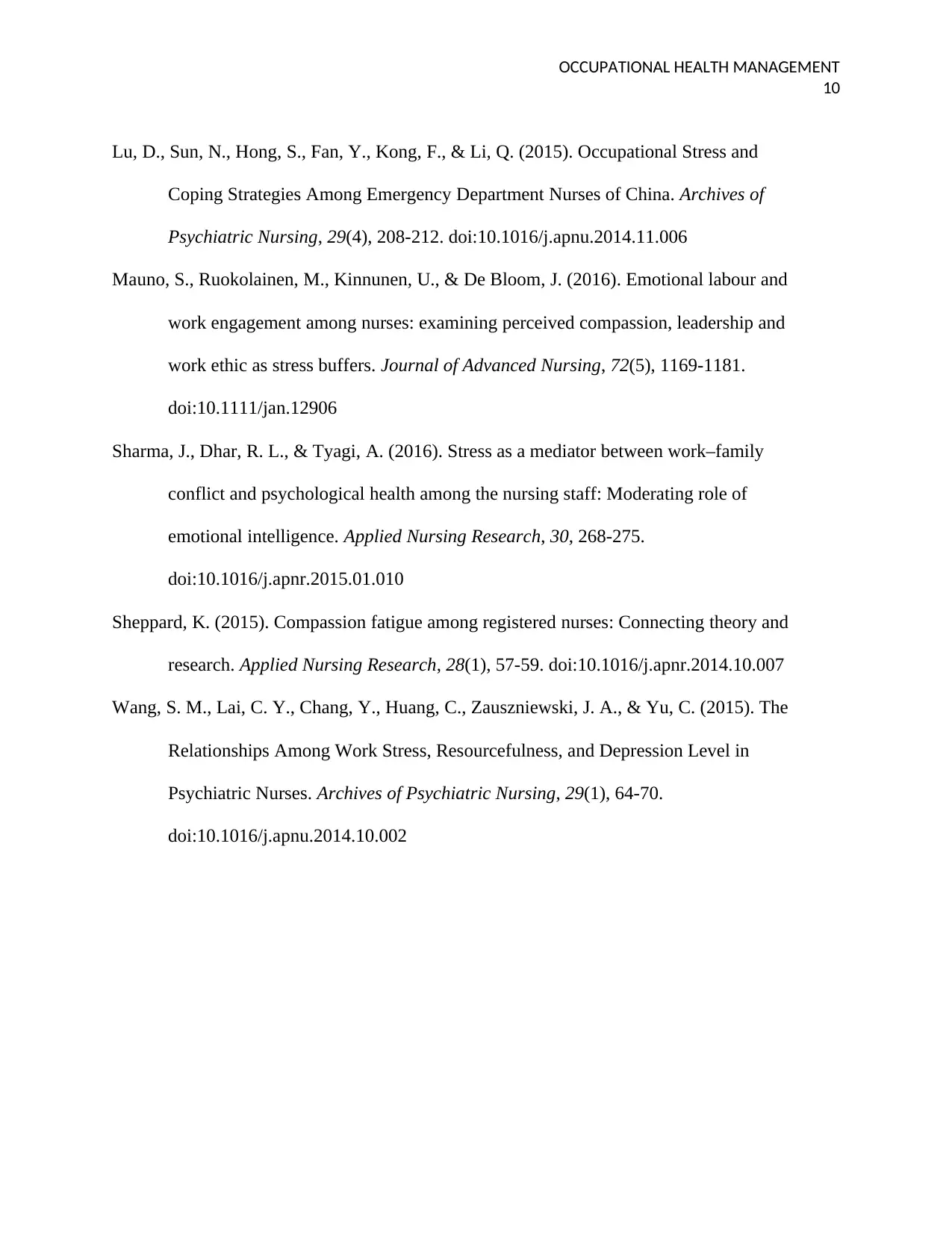
OCCUPATIONAL HEALTH MANAGEMENT
10
Lu, D., Sun, N., Hong, S., Fan, Y., Kong, F., & Li, Q. (2015). Occupational Stress and
Coping Strategies Among Emergency Department Nurses of China. Archives of
Psychiatric Nursing, 29(4), 208-212. doi:10.1016/j.apnu.2014.11.006
Mauno, S., Ruokolainen, M., Kinnunen, U., & De Bloom, J. (2016). Emotional labour and
work engagement among nurses: examining perceived compassion, leadership and
work ethic as stress buffers. Journal of Advanced Nursing, 72(5), 1169-1181.
doi:10.1111/jan.12906
Sharma, J., Dhar, R. L., & Tyagi, A. (2016). Stress as a mediator between work–family
conflict and psychological health among the nursing staff: Moderating role of
emotional intelligence. Applied Nursing Research, 30, 268-275.
doi:10.1016/j.apnr.2015.01.010
Sheppard, K. (2015). Compassion fatigue among registered nurses: Connecting theory and
research. Applied Nursing Research, 28(1), 57-59. doi:10.1016/j.apnr.2014.10.007
Wang, S. M., Lai, C. Y., Chang, Y., Huang, C., Zauszniewski, J. A., & Yu, C. (2015). The
Relationships Among Work Stress, Resourcefulness, and Depression Level in
Psychiatric Nurses. Archives of Psychiatric Nursing, 29(1), 64-70.
doi:10.1016/j.apnu.2014.10.002
10
Lu, D., Sun, N., Hong, S., Fan, Y., Kong, F., & Li, Q. (2015). Occupational Stress and
Coping Strategies Among Emergency Department Nurses of China. Archives of
Psychiatric Nursing, 29(4), 208-212. doi:10.1016/j.apnu.2014.11.006
Mauno, S., Ruokolainen, M., Kinnunen, U., & De Bloom, J. (2016). Emotional labour and
work engagement among nurses: examining perceived compassion, leadership and
work ethic as stress buffers. Journal of Advanced Nursing, 72(5), 1169-1181.
doi:10.1111/jan.12906
Sharma, J., Dhar, R. L., & Tyagi, A. (2016). Stress as a mediator between work–family
conflict and psychological health among the nursing staff: Moderating role of
emotional intelligence. Applied Nursing Research, 30, 268-275.
doi:10.1016/j.apnr.2015.01.010
Sheppard, K. (2015). Compassion fatigue among registered nurses: Connecting theory and
research. Applied Nursing Research, 28(1), 57-59. doi:10.1016/j.apnr.2014.10.007
Wang, S. M., Lai, C. Y., Chang, Y., Huang, C., Zauszniewski, J. A., & Yu, C. (2015). The
Relationships Among Work Stress, Resourcefulness, and Depression Level in
Psychiatric Nurses. Archives of Psychiatric Nursing, 29(1), 64-70.
doi:10.1016/j.apnu.2014.10.002
1 out of 10
Related Documents
Your All-in-One AI-Powered Toolkit for Academic Success.
+13062052269
info@desklib.com
Available 24*7 on WhatsApp / Email
![[object Object]](/_next/static/media/star-bottom.7253800d.svg)
Unlock your academic potential
Copyright © 2020–2025 A2Z Services. All Rights Reserved. Developed and managed by ZUCOL.





